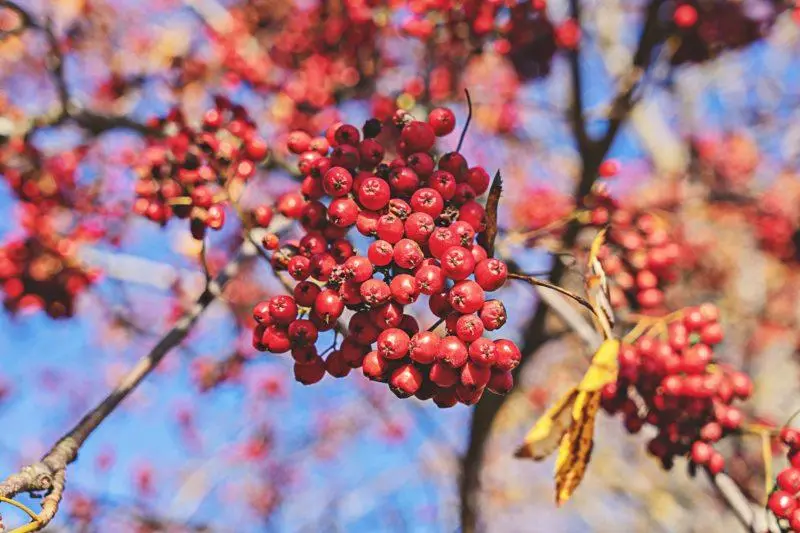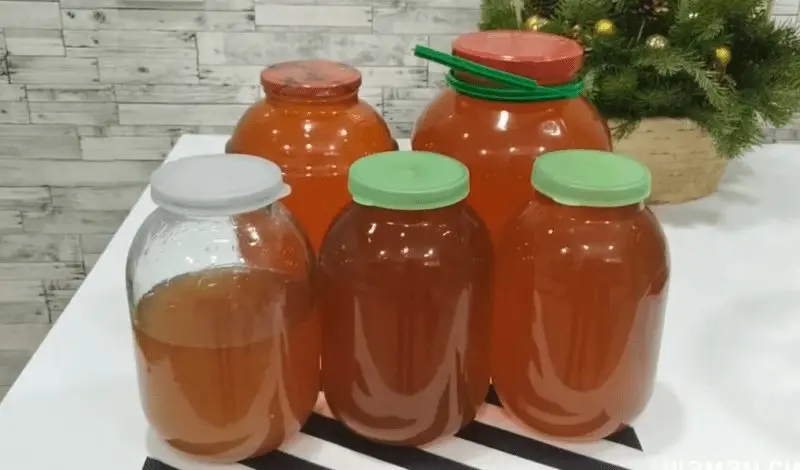Contents
Mountain ash (lat. Sórbus) is credited with many useful properties. In traditional medicine, it is used as a diuretic, multivitamin and hemostatic drug; in the folk – to lower blood pressure, as a choleretic agent, a cure for scurvy and an antiseptic. But not many people know that the almost ubiquitous mountain ash is an excellent raw material for making homemade wines. So, in this article, you will learn how to make homemade red rowan wine without special technical devices and other industrial pieces.
In its pure form, mountain ash is rarely used for making wines, since the berries contain a lot of tannins (0,4% or more). Because of this, the wine is very tart and with a noticeable bitterness. However, long-term aging does its job – the bitterness goes away, and tannins, on the contrary, improve the quality of the wine and make it very resistant to various diseases.

The wine itself is yellow-orange in color, easily clarified and easy to drink. The fruits of the plant are more suitable for making dessert wines (including liqueurs) and fortified wines – for table wines it is better to use special varieties of mountain ash, which have a lot of sugar and less tannins. However, for beginners, we advise making any wines dessert or liqueur – so the probability of spoiling the drink is minimal.
Choosing raw materials (types of red rowan)
The rowan that grows almost everywhere, even in the Far North, is worse for winemaking than varieties specially grown for home use (it contains 0,5% tannins, only 5% sugar and this is the maximum). If you decide to make wine from such mountain ash, then the berries should first be soaked a couple of times in boiling water to partially remove tannins. To improve the extraction of juice, the mountain ash should be frozen (put in the freezer for 2-3 hours), and ideally, harvest the fruits in the first frosts.
Still, it is better to use mountain ash with large fruits, for example, yellow-fruited or Crimean (Sorbus domestica), the fruits of which reach a diameter of 3,5 cm, and their sugar content sometimes reaches 14%.
red rowan wine recipe

Important! To get started, check out the recipes for making apple and plum wines – they describe the fundamental canons for making fruit and berry wines. Recall the main stages of the preparation of fruit and berry wines:
- Preparation of fruits and berries.
- Getting juice.
- Juice research.
- Flavoring, improving the juice and preparing the wort.
- Setting for fermentation.
- Infection of wort with yeast fungi.
- Violent fermentation.
- First filtration and transfer.
- Quiet fermentation and wort care.
- The second and subsequent transfusions of wine.
- Maturation and aging of the drink.
- Cleaning, clarification and preparation for bottling.
- Spill.
- Storage.
- Treatment of vices and diseases of wine.
Again, as in the case of apple wine, due to the characteristics of mountain ash as a raw material, we will cover only a few of these stages. So let’s go!
Preparation of mountain ash and extraction of juice from it
If you use ordinary mountain ash and did not collect it in the first frosts, put it in the freezer for 2-3 hours. Then transfer it from the freezer to a regular refrigerator. Then it needs to be thermally processed. Of course, first you need to clean the mountain ash from the ridges, rotten and dry berries. After that, pour boiling water over the fruits and leave it all for 20 minutes, then drain the water and pour boiling water again – drain again after 30 minutes. Everything, the berries are ready to extract juice from them.
So, in order to get wine from red mountain ash, you first need to extract juice from the fruits. To do this, berries scalded with boiling water or ordinary fruits of home varieties must be kneaded with your hands, a wooden rolling pin (it is undesirable to use metal) or any other device, for example, you can pass the berries through a meat grinder. Then squeeze the juice out of the pulp using gauze or a fine sieve, as you prefer.
In principle, the pulp can be poured with hot water (70-80 оC) and after a few hours mix with the extracted juice, but we do not recommend doing this – just in the pulp there are a lot of polyphenolic substances and pectins, so nothing good will come of this. However, if this does not scare you, and you use, for example, Crimean mountain ash, you can try diluting the pulp with water (you can find its amount in the tables below), and then add juice to it (just let the water cool to 30 degrees), half of the required amount of sugar and a yeast base (more on this in the next chapter.)
In this case, we use fermentation to more effectively separate the juice from the pulp and completely infect the must with yeast fungi. Put the prepared wort under gauze for 2-4 days in a dark warm place (18-25 оC) and after the appearance of signs of fermentation (hissing, sour smell, formation of a dense cap from the pulp). After, squeeze the fermented juice and put it on a quiet fermentation.
Preparation of wort, infection with yeast fungi
In the resulting juice from mountain ash (this option is for those who decide not to use the pulp), you need to add water and sugar in the amount indicated in this table:
To make 100 liters of wort to prepare 80 liters (120 bot.) red rowan wine
Where, 1 – light table, 2 – strong table, 3 – strong wine, 4 – dessert, 5 – liqueur.
As you can see, the table shows calculations for a large amount of wine, and the calculation is solely for the separated rowan juice. This is very convenient – collect any amount of mountain ash, squeeze the juice out of it and then simply recalculate the amount of other ingredients according to the table.
The resulting wort must be infected with yeast fungi. You can use any yeast starter for this. The easiest way to make it is from raisins or fresh crushed grapes (but not washed). Of course, you can make sourdough from raspberries, for example, but in the fall, as you understand, it is almost impossible to get it.
To make a starter from raisins, you need to take a handful of it and rinse it with warm (not hot!) Water, pour it into any container, add 1 tablespoon of sugar, ½ teaspoon of ammonia and pour everything with warm boiled water. Leave the starter in a warm place for 3-4 days and then, if fermentation has begun, add it to the prepared must.
We also want to remind you that the sugar content of the original wort should not exceed 10-14%, so it is better to add sugar in portions, for example, 50 g per liter of wort in several steps. After our wort ferments vigorously for 3-4 days, it must be filtered and poured into bottles for quiet fermentation, filling them ¾ of the total volume.
Silent fermentation of must from red rowan
After pouring into the bottles, you should install a water lock (here is its description and a small manual on the topic of self-production), you can use rubber gloves with a hole in one finger (pierce with a needle). The bottles should be placed in a dark, warm place (18-28°C) and left alone until fermentation stops – the water seal does not blow bubbles for 1-2 days, or the glove is blown off, the wine brightens and precipitates.
At the same time, if fermentation is greatly weakened, which can be traced by the intensity of the release of water seal bubbles, and you decide to add sugar in portions, drain a small amount of wort from the fermentation tank, dissolve the next portion of sugar in it and pour the syrup back. Don’t forget to install the water seal again.
Pouring and maturation of rowan wine, storage
After fermentation is complete, drain the red rowan wine from the sediment into a clean glass container using a rubber tube. The container must be tightly closed (and it is better to install a water seal) or send the wine to mature in a cool place (10-16°C) for 3-4 months. After the expiration date, the drink is once again drained from the sediment and bottled, which later need to be stored in the refrigerator or cellar. As practice shows, mountain ash wine is completely clarified after a year of storage, then the bitterness disappears.
More importantly, rowan is very often used in tandem with other fruits to increase their strength and astringency. The most popular tandem is rowan + apples.
Red rowan and apple wine recipe

In principle, the process of making apple-rowan wine is no different from classical winemaking. First, we compose the wort using the following tables:
To make 100 liters of must from a mixture of red rowan and apples for the preparation of 80 liters (120 bot.) of apple-rowan rosé wine
Where, 1 – light table, 2 – strong table, 3 – strong wine, 4 – dessert, 5 – liqueur.
To make 100 liters of a must from a mixture of red rowan and apples for the preparation of 80 liters (120 bot.) of light apple-rowan wine
Where, 1 – light table, 2 – strong table, 3 – strong wine, 4 – dessert, 5 – liqueur.
Where to get tartaric and tannic acid is written in the recipe for making plum wine.
To compose the wort: prepare, as described in the first chapters of this article, rowan berries, squeeze the juice out of them and add the juice from sweet and sour apples to it. Then add half the sugar, the right amount of water and other ingredients, and then everything is classic: rapid fermentation for 3-4 days, pouring, quiet fermentation for about a month under a water seal with the addition of the rest of the sugar, pouring again, settling in the cold, storage .
So, now you know how homemade red rowan and apple wine is made, and now you can surprise your guests with an unusual drink that they will definitely like. Recall that with the help of wild yeast, the wine will turn out with a strength of no more than 11-14%, but even this is enough to break away. Drink moderately and wisely!









